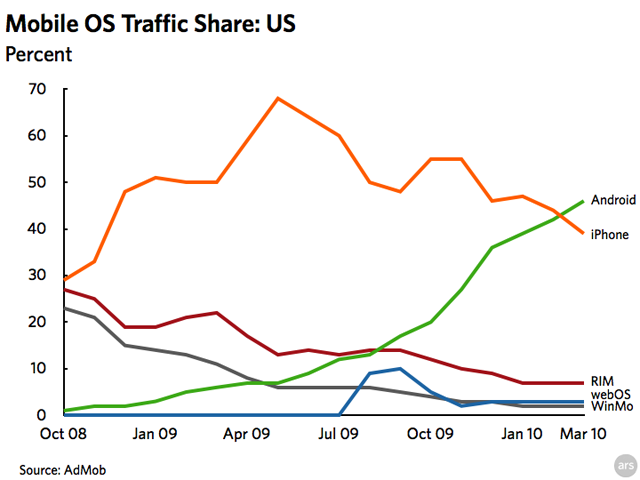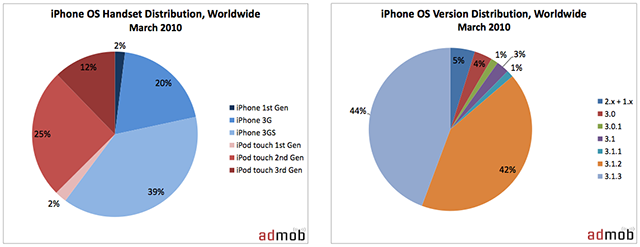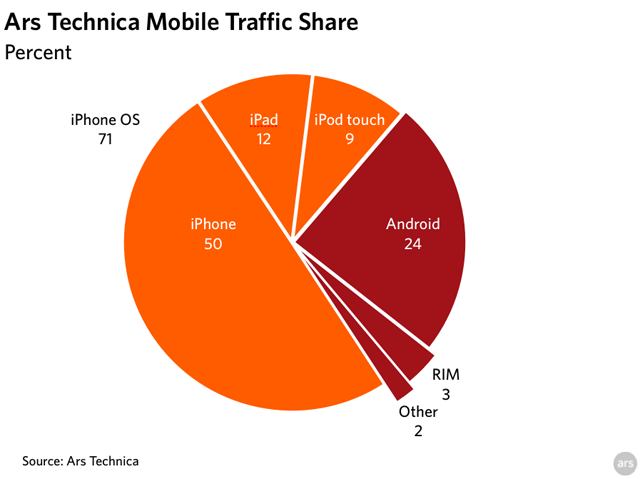Mobile advertising firm AdMob's latest Mobile Metrics Report for March continues to show how the release of new Android-based smartphones in the last few months has affected the market: competition has heated up as Android has pushed past iPhone OS in the US. Historical data suggests an iPhone surge may be coming this summer, but Apple's recently announced iAd may also introduce a wrinkle in AdMob's data. Breaking down data between different iPhone OS devices and OS versions reveals some interesting details about the strength of the iPhone OS platform, including a clear reason why first-gen iPhones and iPod touches are being left out of the iPhone OS 4 party.
Worldwide, things aren't much different than the last few months. According to AdMob's traffic data, iPhone OS still has a commanding lead among smartphone platforms, though its share has dropped 5 percentage points in the last month. Android is still strong in second with a steady increase in share. Symbian also has a nice uptick, as did RIM. Windows Mobile and webOS dropped even further, with Palm's future uncertain and Window Phone 7 release still to come later this year. (We debated even keeping the latter two on this chart, with only 1 percent share each worldwide.)

In the US, competition between Android and iPhone is getting fierce, with the iPhone 3G and 3GS competing against several new Android models now available, in particular the Motorola Droid. For the first time, ad traffic to Android devices exceeded that of iPhones on AdMob's network. The iPhone had a much larger market share by units sold last year, though Android has been gaining quickly in the last few months, especially in the US. It's worth noting, also, that AdMob doesn't include traffic to iPod touches when comparing smartphones—iPhone OS traffic is still higher overall compared to Android. We expect a bump this summer when the 4th-gen iPhone hardware launches—this has happened every summer when new iPhone hardware becomes available and sales surge—though it's unclear what effect iAd might have on AdMob's ad traffic data with respect to iPhone OS devices.
With no discernible change, RIM, WinMo, and webOS hold steady at the bottom of the charts.

When looking at the breakdown of iPhone OS data comparing OS versions as well as device generations, several key data points are revealed. iPhones still account for more traffic on AdMob's network than iPod touches, with roughly a 60-40 split. Given that Apple has continued to sell record numbers of iPhones in the last few quarters, it's no surprise that the iPhone 3GS traffic outnumbers the iPhone 3G two to one. One "anomaly" in the data shows that traffic from second-generation iPod touches outnumbers third-gen devices two to one. Still, considering the fact that the current entry-level, $199 iPod touch is actually a second-gen device, the disparity makes sense.

Looking at the data in a slightly different way, third-generation devices account for 51 percent, second-generation devices account for 45 percent, and first-generation devices only account for four percent of AdMob's traffic. Though first-gen iPhones and iPod touches don't differ significantly from second-gen, it's clear why Apple wouldn't want to invest in making sure iPhone OS 4.0 runs on and is well optimized for the relatively small number of these older devices still in use.

When looking at the traffic breakdown among various iPhone OS versions, users present iPhone developers with a much easier choice when targeting certain features compared to four wildly different versions of Android on various devices. Ninety-five percent of iPhones and iPod touches are running some version of iPhone OS 3.x, with 86 percent running either 3.1.2 or 3.1.3. Given that half that number are still on 3.1.2—even though iTunes will remind you every time you sync that there is an update—it's clear that jailbreaking is still very popular among iPhone users. (We suspect "illicit" tethering on AT&T is a big reason behind this.)

Surprisingly, there are about five percent of users who are still running a 2.x or 1.x version of iPhone OS. Our only conclusion is that these people are never going to upgrade, and chances are good that they aren't using apps beyond those supplied by Apple.
UPDATE: Per a reader comment, below is a breakdown of Ars traffic from various mobile platforms for the last 30 days. We've also broken down traffic from various iPhone OS devices (iPhone, iPad, and iPod touch). iPhone OS traffic has increased four percent, while Android, RIM, and others are down slightly over the preceding 30 day period.

reader comments
80